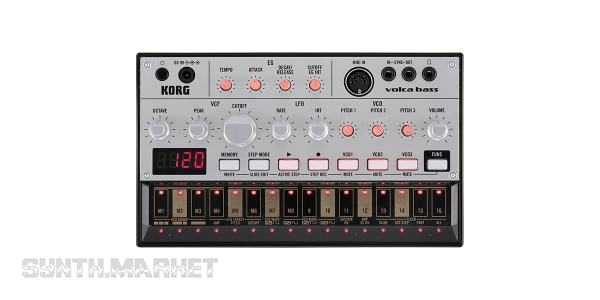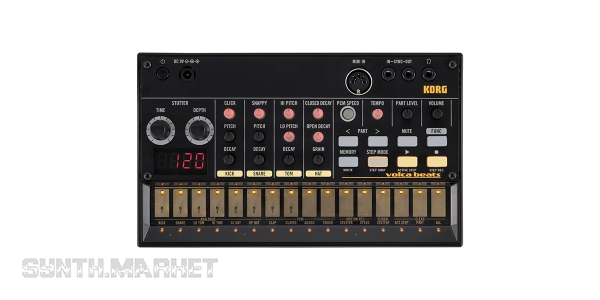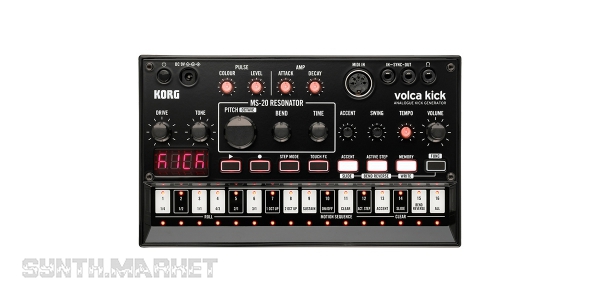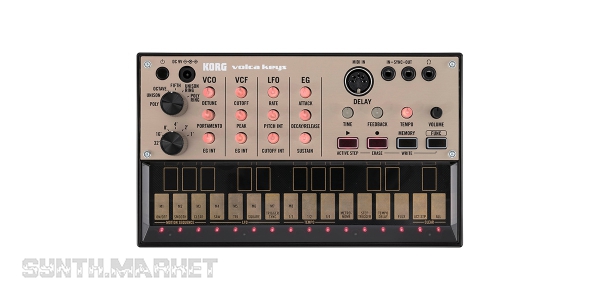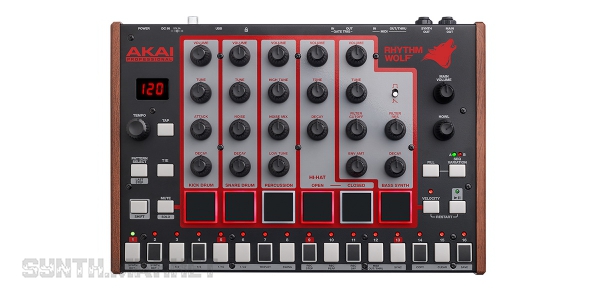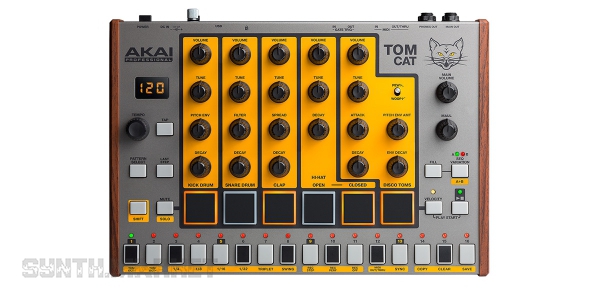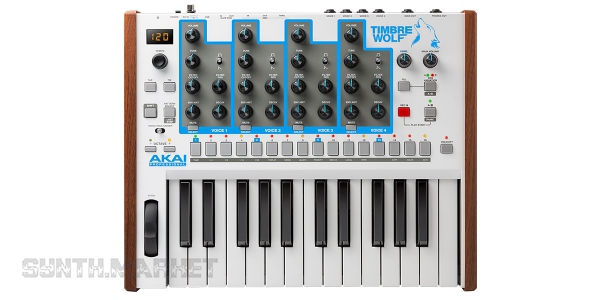First of all, let’s take for example Korg Volca – its funny name actually means a “volcano”. The series comprise various devices: Bass, Beats, Kick and Keys which function accordingly to their titles although possess similar characteristics. The thing that all of them are monophonic keyboard-less synthesizers also makes them tool-relatives. Each machine has the same dimensions, almost the same weight and is equipped with 6 AA batteries. All the devices have MIDI IN as well as sync in/out. There are also mini jack cables (3.5mm or 1/8'') included for sync sockets wich let you integrate Volca synths with each other. All the devices have a built-in speaker. The price of each unit is also about to be the same - $140. Their sound can compete with that of the superfine and pricey instruments and their portability and compact size as well as great integration possibilities lure more and more musicians.
Volca Beats offers an assorted drum and percussion library: kicks, snares, toms, hi-hats are absolutely analog while claps, claves, agogos and crashes are PCM-sampled. All the analog drums have 3 basic knobs: kick for example has Click, Pitch and Decay. Managing these parameters you can easily achieve any variation from a slight crack to an extended TR-808-like kick (you might as well find it... jaw-dropping, just watch your speakers stand firm). Snare can be played about with thanks to a famous "SNAPPY" knob (TR-909 style). PCM parameter change is not so versatile as it is designed for the analog ones. "PCM SPEED" knob is directly responsible for pitch and length of a sample. You’ll definitely enjoy pattern recording with the 16-step sequencer. It allows to record in real time or enter some of the steps manually and there you’ll have parameter automatization. On the left side of the device you’ll find a section with a "STUTTER" effect which can be applied as a delay though its original function is to serve as an abrupt repeat of any of the fragments.
Not so long ago Volca Kick came out – in October this year. It’s worth noting that it wasn’t developed in order to substitute Beats, quite the opposite – Korg intended it to be used together with Beats since Kick was created with a little bit different purpose. This time Korg decided to avoid that typical approach to kick synthesis and gave it just a single standard sine wave which replicates that one from "MS-20 RESONATOR" – the filter based on the Korg MS-20 classic filter circuit. The central section comprises Pitch, Bend and Time parameters and a bit higher there are controls for Click (to increase or reduce the click intensity) as well as attenuator with attack and decay knobs. You’ll have some fun exploring the depths of the kick range with the help of its edit possibilities. There is a distortion to add some aggressiveness and expression to the sound. As well as other units of the series Kick features a 16-step sequencer and effects available in real time mode for stunning performance.
Volca Bass was developed in Japan and is being assembled in Vietnam. It has a fully analog signal output but Korg elaborated a bit on this saying that “control signals are generated digitally and CPU has a 10-bit DAC giving incredible near-analogue resolution”. So that’s what they mean claiming Bass provides analog signal path. In fact this is a hybrid device with analog sound core and digital control which allows recording of the parameter and sequencer note change through MIDI. Its looks and colors bring us back to legendary TB-303 although their sound capabilities have little in comon. You can feel the difference mainly due to its classic 2-pole (12dB) low pass filter which used to be the component of MiniKorg-700S of 1974. The sound core of the synthesizer is made of 3 analog oscillators. They can work either independently or together. Actually these functions bring even more to what we might expect: when the sound sources are put to operate individually the sequencer allows to record steps for each voice separately. Moreover each oscillator has its own LFO and pitch control.
Volca Keys seems to have more parameters than other Volca units. The interface features 4 sections with 12 knobs among which there are controllers for VCO, VCF, LFO and envelope generators. The waveforms are selectable: in main polyphonic mode there are sawtooth wave shapes for each of the 3 oscillators; square waveforms are available for "UNISON" and "POLY RING" modes only. On the right side of the synthesizer board there is a delay effect (not like that one in Volca Beats) with time and feedback controllers. Delay and tempo are easily synced via MIDI or Sync option. Volca Keys sequencer has an internal metronome to make recording in real time simpler but unlike its “brothers” it lacks step by step mode. Nevertheless besides recording in real time it offers automatization for each enabled parameter. It’s getting obvious that Volca mini-synths replaced Monotribe and Monotron power couple. Any of them is quite a bargain owing to such advantages as authentic analog synthesis, sequencer, ability to save parameter change in real time, portability and gainful “price/functionality” proportion.
Those who’ve been searching for a budget alternative to Elektron Analog Rytm might be happy to hear that AKAI Rhythm Wolf is tailored to suit your expectations from the functions Rytm made you want so much. Of course Wolf doesn’t possess the unlimited possibilities of that Swedish top synthesizer. Rhythm Wolf is a classic drum machine with a built-in sequencer and incorporates only analog drums and analog monophonic bass synth. The device includes a 16-step sequencer with A/B switch (32 steps in total). Each of the 6 pads is touch sensitive and assigned to a certain drum sound. There are 5 drum types in the library and each offers 3 knobs to alter sound nuances. Kick is quite brutal or even wolfish (let’s pay some respect to the name), attack controller can enhance its “clicking” attribute or create an extended boom kick sound turning the knob fully clockwise. Snare after noise removal sounds like a rimshot but if you add some it will become much edgier leaving soft noisy background. Percussion (unlike snare) offers much more parameters which allow to control the lower and the upper pitch parts. And finally we have this hi-hat – bright and truly metallic. If you integrate Rhythm Wolf with another instrument through MIDI out Akai’s drum machine will send MIDI data in the order it is recorded. That’s how you can manage the sequencer of another monophonic instrument making Rhythm a master or create layers between a slave synth and the bass section of the drum machine. Its sequencer can be connected to some DAW via MIDI sync. The bass synth won’t spoil you with abundant functionality, it doesn’t have “glide” mode, but anyway even without resonance it emits a decent sound, there is also a selection possibility between 2 waveforms – saw and square (TB-303 offered those ones as well). While adjusting the resonance knob you can make low frequencies jucier and going up to high frequencies you’ll get a fine subtle wave. It’s worth noting that the bass section has its own separate output so it can be processed with external equalizers, filters, compressors or effects processor. Some might get skeptical but we dare to say it - Rhythm Wolf is all about that warm tape sound. It may not seem a full-value drum machine but $170 will surely change your mind about its voice and about the fact that it’s not like that one of top devices because, well, it’s not. But this synth is definitely the best choice among other units of the same price and to put a full stop – it’s assembled really good within solid metal panels.
Another analog percussion synth AKAI released a bit later in 2016 is called Tom Cat. As well as other Akai’s analog products Tom Cat architecture is enclosed into metal construction with wooden sides. 6 touch sensitive pads with rubber coat were copied from Akai MPC. The rear panel features Gate, MIDI in/thru, USB (for computer), jacks for headphones and external power supply. The design is almost identical to Rhythm Wolf but the drums are not similar as it may seem at first sight (the knobs are different).
The library includes 6 drum sound types: kick, snare, clap, closed/open hi-hat and exclusive disco toms. Kick of Tom Cat has nothing in common with the kick of Rhythm Wolf because Akai enables pitch envelope control in Tom Cat. There are 3 more parameters: tuning, pitch envelope and decay. These knobs will open to you the palette of textures from classic TR-808-like sub bass to euphonious fusion with disco toms. Comparing to Rhythm Wolf you’ll find this drum machine sounds punchier and deeper. Snare also has a peculiar timbre, plus there are knobs for high pass filter and decay (provides a surprisingly long decay which ends up in cymbals ensued from noise generating). We should also note that touch sensitive pads affect snares character immensely which is lost when operating in step sequencer mode. Tom Cat clap echoes the one from TR-808/909. It’s a bit more virulent due to its direct interaction with IF filter. In its section there are controllers for pitch, decay and spread. As well as the snare the clap has a long sonic trail. Unfortunately open and closed hi-hats are nothing interesting in regard to their settings options because the manipulation with pitch give you quite boring results. Anyway their timbre is still as good. But we’ve got disco toms to be happily shocked with. Thanks to their parameters we can create alternative kick versions or laser disco from the 70s style effects (at least we guess that’s why they’re called “disco”). The angry cat which name is Tom is depicted on the upper right side of the synth and most likely symbolize “Maul” control which in its turn adds some overdrive to the mix. The sequencer of the percussion synthesizer is simple enough in use: it can be applied traditionally in a step mode or you can record in real time with the help of quantization. As concerns beats per measure the steps can be 1/4, 1/8, 1/16, 1/32 and so on. There are 16 patterns for each A/B. On the whole Tom Cat is a charming and unique drum machine and the price of $190 adds up. If you can waive your desire to have drums and bass synth Rhythm Wolf can offer then be sure you won’t regret preferring Tom Cat – it will meet all your expectations (of Tom Cat of course). Although it can be intagrated with Wolf quite easily as well, all the 3 synths of the series have Gate Trigger in/out.
The analog synthesizer AKAI Timbre Wolf appeared on the shelves in 2015. The instrument can boast of quality dynamic 2-octave keyboard with full-size keys (no aftertouch though) and interesting structure consisting of 4 independent voices segmented as in Korg Mono/Poly. But Korg moved on or we might say took another direction: each voice has individual settings for volume, pitch, decay, filter as well as features an integrated 32-step sequencer with A/B switches which can control all the voices at once or each voice individually.That’s why Timbre Wolf is a multipurpose device. Each of the 4 voices includes the same sections Rhythm Wolf does but with the only exception: the voices can be altered with a pitch knob. The quality of oscillator signal output proves to be competitive on the market of analog instruments. It’s no secret that the parameters of Timbre Wolf are reminiscent of those in classic TB-303. Each section comprises an oscillator with saw and square waveforms as well as resonant low pass filter. The decay knob can serve as an amp or for cutoff adjusting. Actually you become an owner of four TB-303 units which function here as four mono synths. As for polyphony it can be switched between poly, mono or chord mode. If you play with a “Howl” knob you’ll find yourself exploring a wide range of distortions and obertones and it will not only distort but also increase master volume to a risky extent (putting speakers at their extreme) and you’ll find “rec” and “panic” buttons (thanks Akai, you’ve got a nice sense of humor) located a bit lower – they don’t imply so much that you should panic but more of wink at you: “don’t panic it’s just euphoria”. Although “Howl” is a bit noisy. You can make fun when you’re on stage but don’t make fun with it in studio.
Timbre Wolf is the most expensive on the list but the price happens to be often reduced so you can find a unit less than for $300 still not going broke. Owing to its elaborate design and peculiar sound Timbre Wolf is a reliable multifunctional fully analog synthesizer. 4 oscillators allow to create lots of sound variations: from ambient textures to voluminous leads, and its 16-step sequencer is perfect for tricky polytimbral groove. If you let it be a master synth and lead without intervention from your hands you’ll have enough of fingers to add juicy notes while receiving MIDI or analog Gate signals to help you with the track. You can also put to use 4 individual analog wave outputs for postprocessing. But we recommend you to keep yourself away from those haters standing in line to profane analog synths Akai make (and you’ll find that kind of critics on the Internet). If you dig a little you’ll discover that this trio Timbre Wolf - Tom Cat - Rhythm Wolf deserves respect. The only thing Akai is to be blamed for here is that noisy Howl/Maul issue but it’s curable.
Both companies KORG and AKAI have always put their efforts into improving the proportion of basic/intuitive interface and set of functions doing their best with the instruments. Their synths and drum machines are not to be matched or opposed because each unit is good in its own unique way. Some Volcas feature analog signal with a touch of digital presence (Beats, Bass) and Korg shows the tendency to keep on expanding the series and now we’ve got this anlog Volca Kick which was launched not so long ago. Considering the number of the functions Akai seems to stand out and excel Volca though it has its limits as well. It’s up to you which one to choose and we’re waiting for your comments.

